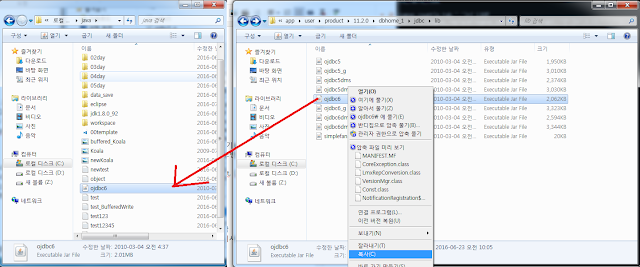오라클SQL- 오라클 내부의 데이터 조작 방법
자바에서 데이터란
- 임시
- 변수/ 상수
- 영구
- 로컬
- 파일
- 원격
- 데이터베이스
- JDBC : 자바에서 데이터베이스 프로그램 다루는 기술
- 데이터베이스 연결 프로그램 파일찾아, 인스턴스 생성
- 연결 관리 CONNECTION 객체 생성
- 작업 처리할 Statement, preparedStatement, CallableStatement 객체 생성
- ResultSet 객체를 통한 Query 결과 처리
- 접속 종료
- java → java.sql →database driver →데이터베이스
- →database driver →데이터베이스
- database driver는 데이터베이스 업체에서 제공함
오라클용 database driver찾으려면 오라클 폴더에서 찾아야함
import java.sql.Connection;
import java.sql.DriverManager;
import java.sql.SQLException;
public class jdbcEx01 {
public static void main(String[] args) {
try {
// 드라이버클래스 로딩
Class.forName("oracle.jdbc.driver.OracleDriver");
System.out.println("데이터베이스 로딩 성공");
} catch (ClassNotFoundException e) {
// TODO Auto-generated catch block
System.out.println("[에러] : "+e.getMessage());
}
//String url = "jdbc:oracle:thin:@서버아이피:서버포트:오라클sid";
//서버포트 C:/app/user/product/11.2.0/dbhome_1/NETWORK/ADMIN/listener 파일에서 확인
// 127.0.0.1 아이피는 자신만 사용
String url = "jdbc:oracle:thin:@192.168.0.80:1521:orcl";
String user = "scott";
String password = "tiger";
Connection conn = null;
try {
//데이터 베이스 접속
conn = DriverManager.getConnection(url, user, password);
System.out.println("데이터베이스 연결 성공");
} catch (SQLException e) {
// TODO Auto-generated catch block
System.out.println("[에러] : "+e.getMessage());
} finally {
if(conn != null) try { conn.close(); } catch(SQLException e){}
}
}
}
//소스코드 정리
import java.sql.Connection;
import java.sql.DriverManager;
import java.sql.SQLException;
public class jdbcEx02 {
public static void main(String[] args) {
//String url = "jdbc:oracle:thin:@서버아이피:서버포트:오라클sid";
//서버포트 C:/app/user/product/11.2.0/dbhome_1/NETWORK/ADMIN/listener 파일에서 확인
// 127.0.0.1 아이피는 자신만 사용
String url = "jdbc:oracle:thin:@192.168.0.80:1521:orcl";
String user = "scott";
String password = "tiger";
Connection conn = null;
try {
// 드라이버클래스 로딩
Class.forName("oracle.jdbc.driver.OracleDriver");
System.out.println("데이터베이스 로딩 성공");
//데이터 베이스 접속
conn = DriverManager.getConnection(url, user, password);
System.out.println("데이터베이스 연결 성공");
} catch (ClassNotFoundException e) {
// TODO Auto-generated catch block
System.out.println("[에러] : "+e.getMessage());
} catch (SQLException e) {
// TODO Auto-generated catch block
System.out.println("[에러] : "+e.getMessage());
} finally {
if(conn != null) try { conn.close(); } catch(SQLException e){}
}
}
}2
package jdbcEx01;
import java.sql.Connection;
import java.sql.DriverManager;
import java.sql.SQLException;
import java.sql.Statement;
public class jdbcEx03 {
public static void main(String[] args) {
String url = "jdbc:oracle:thin:@192.168.0.80:1521:orcl";
String user = "scott";
String password = "tiger";
Connection conn = null;
//Statement 만들기 : sql문을 던질수 있는 박스
Statement stmt = null;
try {
// 드라이버클래스 로딩
Class.forName("oracle.jdbc.driver.OracleDriver");
System.out.println("데이터베이스 로딩 성공");
//데이터 베이스 접속
conn = DriverManager.getConnection(url, user, password);
System.out.println("데이터베이스 연결 성공");
//Statement 생성 --dept테이블 데이터 추가
stmt = conn.createStatement();
//stmt.executeUpdate("insert into dept values(90, '개발', '서울')"); //직접 적는 것 가능함
//String sql = "insert into dept values(91, '총무', '부산')"; //문장을 sql변수로 빼는것 가능함
//각각의 변수를 생성하고 문자열 연결
String deptno= "92";
String dname= "회계";
String loc= "대전";
//String sql = "insert into dept values("+deptno+", '"+dname+"', '"+loc+"')";
String sql = String.format("insert into dept values(%s,'%s','%s')", deptno, dname, loc);
stmt.executeUpdate(sql);
System.out.println("SQL 실행 성공");
} catch (ClassNotFoundException e) {
// TODO Auto-generated catch block
System.out.println("[에러] : "+e.getMessage());
} catch (SQLException e) {
// TODO Auto-generated catch block
System.out.println("[에러] : "+e.getMessage());
} finally {
//Statement 닫기
if(stmt != null) try { stmt.close(); } catch(SQLException e){}
if(conn != null) try { conn.close(); } catch(SQLException e){}
}
}
}
3
import java.sql.Connection;
import java.sql.DriverManager;
import java.sql.SQLException;
import java.sql.Statement;
public class jdbcEx03 {
public static void main(String[] args) {
String url = "jdbc:oracle:thin:@192.168.0.80:1521:orcl";
String user = "scott";
String password = "tiger";
Connection conn = null;
//Statement 만들기 : sql문을 던질수 있는 박스
Statement stmt = null;
try {
// 드라이버클래스 로딩
Class.forName("oracle.jdbc.driver.OracleDriver");
System.out.println("데이터베이스 로딩 성공");
//데이터 베이스 접속
conn = DriverManager.getConnection(url, user, password);
System.out.println("데이터베이스 연결 성공");
//Statement 생성 --dept테이블 데이터 추가
//select 문을 제외한 모든 구문이 사용가능함
stmt = conn.createStatement();
//create 테이블만들기
String sql = "create table aa(col1 varchar2(10))";
stmt.executeUpdate(sql);
System.out.println("SQL 실행 성공");
} catch (ClassNotFoundException e) {
// TODO Auto-generated catch block
System.out.println("[에러] : "+e.getMessage());
} catch (SQLException e) {
// TODO Auto-generated catch block
System.out.println("[에러] : "+e.getMessage());
} finally {
//Statement 닫기
if(stmt != null) try { stmt.close(); } catch(SQLException e){}
if(conn != null) try { conn.close(); } catch(SQLException e){}
}
}
}







댓글 없음:
댓글 쓰기